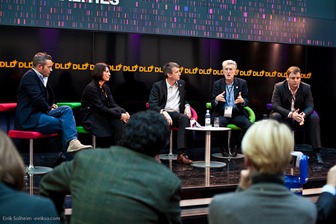No Hope for Traditional Media Companies?
 The Internet is a media platform based on content from traditional media companies (Times Magazine, etc.) as well as content produced by its users blogs, forums and other social communication platforms.
The Internet is a media platform based on content from traditional media companies (Times Magazine, etc.) as well as content produced by its users blogs, forums and other social communication platforms.
This vast new world of content is taking the lead from traditional media. Newspapers, Magazines and TV Channels are all loosing their audience in favor of the internet. Those traditional media companies who do develop strong internet presence are still having troubles as income from online advertising does not cover the decrease in income from traditional advertising and subscription fees.
The New Media Models (video) panel, on last week’s DLD conference, tries to deal with the question of business models that media companies can use to profit on the web.
When asked about what kind of new media outlet they’d start today, non of the panel’s participants would start a print newspaper or a magazine.
“I wouldn’t start a newspaper. There might be a place for a magazine to sit on my coffee table, but not for a NewsWeek or a BusinessWeek or a daily newspaper I think its absurd… I understand why the do it, revenues on print are so great vs. online but it has to go way” said Michael Arrington. According to Arrington we’re going to be consuming our news and other content online or on digital devices and once a certain threshold is reached it’ll no longer be profitable to print. “It doesn’t make any sense for news to be on paper because of its just the cost structure” he summarizes.
Jeff Jarvis said he would start a distributed content network, like Glam. According to Jeff not owning and controlling the data is what allowed Glam to literally explode to more than 110 Million unique users in 3 years. While content owners have to spend a fortune advertising to bring people in, distributed networks just go to where the people are. People today reach content via rating sites like DIGG or Twitter messages and no longer require central content portals to collect, sort, filter and rate content them. Jeff says that media companies need to start asking “How can we build platforms on which others succeed?”, they have to become platforms for content distributed around the web (like YouTube for example) rather than producing and controlling their own content.
On that same note, Arrington added that traditional media sites, who’s cost structure includes all kinds of expenses that do not produce content like programmers, office space can’t compete with an army of bloggers who blog from their home using their laptop and free software.
Carolyn McCall, who is the CEO of Guardian Media Group (representing the “traditional” media companies) confirmed the fact that income from the printing business is going down while internet income, even for a huge company like the Guardian Group, do not compensate for these losses. However, she also mentions that 25 million users use the Guardian’s web and that its income is 300 million dollars a year and that both numbers continue growing.
The panelist could not explain why advertising budget that are taken from the print versions of the media do not move in their entirety to the online advertising world, and they could also not find a definite business model to run media company online (even Jeff’s example for a distributed network Glam is still not profitable and taking VC money) but they all agree that print is phasing out and that there’s a need for a new model for online media and journalism.

